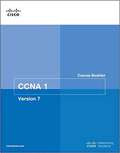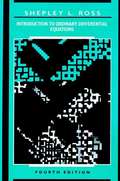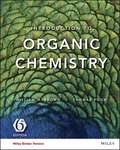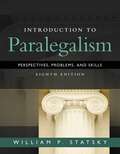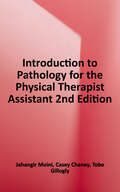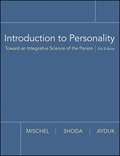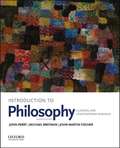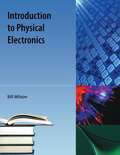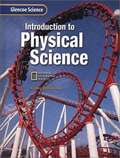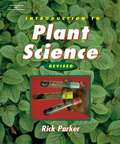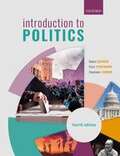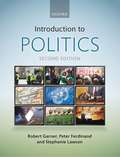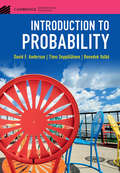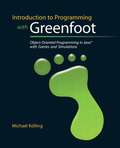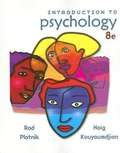- Table View
- List View
Introduction to Networks Course Booklet (CCNA)
by Cisco Networking AcademyYour Cisco Networking Academy® Course Booklet is designed as a study resource you can easily read, highlight, and review on the go, wherever the Internet is not available or practical: The text is extracted directly, word-for-word, from the online course so you can highlight important points and take notes in the “Your Chapter Notes” section. Headings with the exact page correlations provide a quick reference to the online course for your classroom discussions and exam preparation. An icon system directs you to the online curriculum to take full advantage of the images embedded within the Networking Academy online course interface and reminds you to do the labs, interactive activities, packet tracer activities, watch videos, and take the chapter quizzes. <p><p> The Course Booklet is a basic, economical paper-based resource to help you succeed with the Cisco Networking Academy online course. <p><p> This book is offered exclusively for students enrolled in Cisco Networking Academy courses. It is not designed for independent study or professional certification preparation. Visit netacad.com to learn more about program options and requirements.
Introduction to Neuro Development Disabilities -TNOU (Course 4 / 02 #SED-15)
by Tamil Nadu Open UniversityThe course integrates relevant subject matter in the areas of Learning Disability, intellectual Disability and Autism Spectrum Disorder. This course will prepare preservice teachers to work with students with Neuro Developmental disabilities in inclusive and specialized settings. It fosters the acquisition of the broad-based knowledge and skills needed to provide effective educational programs for students with learning and behavior characteristics. The course emphasizes implications for educational and vocational programming, curriculum, and instruction.
Introduction to Ordinary Differential Equations (4th Edition)
by Shepley L. RossFor those having knowledge of elementary calculus, this is a straightforward introduction to the basic concepts, theory, methods, and applications of ordinary differential equations. Designed for a one-semester course in ordinary differential equations, this book covers and emphasizes the most fundamental methods of the subject and also contains traditional applications and brief introductions to fundamental theory.
Introduction to Organic Chemistry
by William H. Brown Thomas PoonIntroduction to Organic Chemistry, 6th Edition provides an introduction to organic chemistry for students who require the fundamentals of organic chemistry as a requirement for their major. It is most suited for a one semester organic chemistry course. In an attempt to highlight the relevance of the material to students, the authors place a strong emphasis on showing the interrelationship between organic chemistry and other areas of science, particularly the biological and health sciences. The text illustrates the use of organic chemistry as a tool in these sciences; it also stresses the organic compounds, both natural and synthetic, that surround us in everyday life: in pharmaceuticals, plastics, fibers, agrochemicals, surface coatings, toiletry preparations and cosmetics, food additives, adhesives, and elastomers.
Introduction to Organizational Behavior and Management (4th Edition)
by Chuck Williams James Campbell Quick Debra L. NelsonLearn more about how people behave in organizations, and how to manage them for greater productivity and worker satisfaction.
Introduction to Paralegalism: Perspectives, Problems and Skills (Eighth Edition)
by William P. StatskyMaster the hands-on skills you'll need to succeed in a modern law office with <i>Introduction to Paralegalism, 8e</i>. Ten critical skills are covered in the book: identifying legal issues, breaking rules into elements, applying rules to facts interviewing clients, investigating facts, digesting discovery documents, providing litigation assistance, researching the law, drafting documents, and representing clients at administrative agencies where authorized by law. Packed with real-life insights and real-world examples, the text helps you understand the ethical guidelines that lawyers and paralegals must follow and covers the efforts underway to regulate the profession in legislatures, courts, bar associations, and paralegal associations.
Introduction to Pathology for the Physical Therapist Assistant
by Jahangir Moini Casey Chaney Tobe Gillogly“Introduction to Pathology for the Physical Therapist Assistant reviews pathological states and conditions that every PTA must understand in order to effectively treat patients. <p><p>The text begins by introducing students to the underlying concepts of health and disease before delving into infection, inflammation, and repair. The core of the book explores the pathology of the body systems, followed by a consideration of environmental hazards and considerations for special populations” <p>Provided by publisher.
Introduction to Personality: Toward an Integrative Science of the Person
by Walter Mischel Yuichi Shoda Ozlem AydukReflecting the latest developments, this eighth edition paints a picture of the field as a cumulative, integrative science that builds on its rich past. It provides a much more coherent view of the whole functioning individual in the social world. Throughout the chapters, emphasis is placed on practical applications and personal relevance to everyday life in a clear and compelling way. The book also explores the essential features and contributions from the field's heritage
Introduction to Philosophy
by John Perry Michael Bratman John Martin FischerIntroduction to Philosophy: Classical and Contemporary Readings is the most comprehensive topically organized collection of classical and contemporary philosophy available. Ideal for introductory philosophy courses, the text offers a broad range of readings and depth. The text includes sections on God and Evil, Knowledge and Reality, the Philosophy of Science, the Mind/Body problem, Freedom of Will, Consciousness, Ethics, Political Philosophy, Existential Issues, and philosophical Puzzles and Paradoxes. (The unique section on Puzzles and Paradoxes is often praised by both instructors and students.) <p><p> Easy to use for both students and instructors alike, the book incorporates boldfaced key terms (listed after each reading and defined in the glossary); a guide to writing philosophy papers; and a “Logical Toolkit;” and study questions after each reading selection. These features have allowed more students to learn philosophy by using what is seen as the highest quality collection of philosophical readings available. The ninth edition will be revised based on reviewer suggestions, and will include more diversity and readings by female philosophers.
Introduction to Philosophy: Classical and Contemporary Readings
by John Perry Michael Bratman John Martin FischerIntroduce your students to philosophy with the most widely used, trusted, and comprehensive topically organized collection of classical and contemporary readings available. <P><P>Easy to use for both students and instructors, Introduction to Philosophy: Classical and Contemporary Readings incorporates boldfaced key terms (listed after each reading and defined in the glossary), a "Logical Toolkit," a guide to writing philosophy papers, and study questions after each reading selection. The eighth edition features nine new selections that broaden the book's scope to include work by non Western philosophers and contemporary women philosophers.
Introduction to Physical Electronics
by Bill WilsonAn introduction to solid state device including field effect and bipolar transistors. Properties of transmission lines and propagating E&M waves.
Introduction to Physical Geography-1 First Semester FYBA New NEP Syllabus - SPPU
by Dr Jyotiram C. More Prof. Harishchandra S. Timbole Dr Manojkumar P. DevneIntroduction to Physical Geography-1 provides a foundational understanding of Earth's natural systems, aligning with the NEP 2024 syllabus for first-year B.A. students. It covers four key areas: the Lithosphere, discussing Earth's interior, continental drift, and erosion cycles; the Atmosphere, exploring weather, climate, and temperature distribution; the Hydrosphere, detailing the hydrological cycle, ocean structures, and water movement; and the Biosphere, examining ecosystems and environmental interactions. The book emphasizes the importance of physical geography in understanding natural processes, resource management, disaster preparedness, and sustainable development.
Introduction to Physical Science
by McGraw-HillA book helping students to understand concepts of physical science.
Introduction to Plant Science (Revised edition)
by Rick ParkerThis revised text provides a comprehensive introduction to the fascinating world of plant science. From the basic requirements for plant growth, to genetic engineering and biotechnology, this easy- to- understand book is ideal for the high school level agriscience curriculum or college freshman level plant science course. Students will learn about the origins of cultivated plants, structure and anatomy, photosynthesis, respiration, propagation, production of major agronomic crops, and more.
Introduction to Political Science-1 First Semester FYBA New NEP Syllabus - SPPU
by Dr Pramod R. Tambe Onkar A. KorwaleThe book “Introduction to Political Science-1” by Dr. Pramod R. Tambe and Onkar A. Korwale is a comprehensive introductory text for F.Y.B.A. students, aligning with the 2024 NEP syllabus. It explores the fundamental concepts of political science, including its meaning, nature, scope, and importance, alongside traditional and modern approaches to its study. Key topics include the concept and evolution of the state, its elements, and theories of state formation, such as the divine, social contract, Marxist, and patriarchal theories. Combining philosophical, historical, and empirical perspectives, the book provides a solid foundation for understanding governance, political institutions, and the dynamics of power in society, catering to the academic needs of students and educators.
Introduction to Politics
by Robert Garner Peter Ferdinand Stephanie LawsonCombining theory, comparative politics and international relations, Introduction to Politics, Fourth Edition, provides the most comprehensive introduction to the subject for first year undergraduate students, with the most global perspective. <p><p> Written by three experts in the field, this book takes a balanced approach to the subject, serving as a strong foundation for further study. Assuming no prior knowledge, the authors use an accessible yet analytical approach which encourages critical analysis and debate, helping students to develop the vital skills they need for future studies and employment. <p><p> The new edition has been fully updated with additional case studies and examples to help students to understand how key theories and principles apply in the context of real-world events. New to the fourth edition is a chapter on 'Non-Western Approaches', which helps students to bring more diverse perspectives to their study of politics. Furthermore, additional coverage of populism has been included, to reflect current events and developments in discourse. <p><p> This ensures that Introduction to Politics, Fourth Edition is the most contemporary, relevant and essential guide for students new to the study of politics.
Introduction to Politics (Second Edition)
by Robert Garner Peter Ferdinand Stephanie LawsonIntroduction to Politics, Second Edition, provides an intellectually stimulating yet accessible introduction to politics that takes current global realities into account. The text is divided into three sections that reflect the authors' expertise: concepts and ideologies, comparative politics, and international relations.
Introduction to Probability
by Charles M. Grinstead Laurie J. SnellAn open source textbook on probability.
Introduction to Probability (Cambridge Mathematical Textbooks)
by David F. Anderson Timo Seppäläinen Benedek ValkóThis classroom-tested textbook is an introduction to probability theory, with the right balance between mathematical precision, probabilistic intuition, and concrete applications. Introduction to Probability covers the material precisely, while avoiding excessive technical details. After introducing the basic vocabulary of randomness, including events, probabilities, and random variables, the text offers the reader a first glimpse of the major theorems of the subject: the law of large numbers and the central limit theorem. The important probability distributions are introduced organically as they arise from applications. The discrete and continuous sides of probability are treated together to emphasize their similarities. Intended for students with a calculus background, the text teaches not only the nuts and bolts of probability theory and how to solve specific problems, but also why the methods of solution work. Presented in full color and written in an accessible way, the text provides a comprehensive and well-balanced introduction to probability. Pedagogical features include numerous examples to illustrate concepts and theory, over 600 exercises of varying levels, and separate 'Finer Points' sections for technical details. Instructor's manual available online with detailed solutions to selected problems and further guidance for using the book in a course.
Introduction to Programming With Greenfoot: Object-Oriented Programming in Java With Games and Simulations
by Michael KöllingIntroduction to Programming with Greenfoot: Object-Oriented Programming in Java with games and Simulations is ideal for introductory courses in Java Programming or Introduction to Computer Science. The only textbook to teach Java programming using Greenfoot--this is "Serious Fun. " Programming doesn't have to be dry and boring. This book teaches Java programming in an interactive and engaging way that is technically relevant, pedagogically sound, and highly motivational for students. Using the Greenfoot environment, and an extensive collection of compelling example projects, students are given a unique, graphical framework in which to learn programming.
Introduction to Programming with C++ (2nd edition)
by Y. Daniel LiangA solid introduction to problem solving and programming using C++, the topics include: Introduction to Computers, Programs, and C++; Elementary Programming; Selections; Loops; Function Basics; Advanced Function Features; Single-Dimensional Arrays; Multidimensional Arrays; Objects and Classes; Class Design; Pointers and Dynamic Memory Management; Templates and Vectors; File I/O; Operator Overloading; Inheritance and Polymorphism; Exception Handling; Recursion; Algorithm Efficiency; Sorting, etc.
Introduction to Psychology
by Charles StangorWhen you teach Introduction to Psychology, do you find it difficult — much harder than teaching classes in statistics or research methods? Do you easily give a lecture on the sympathetic nervous system, a lecture on Piaget, and a lecture on social cognition, but struggle with linking these topics together for the student? Do you feel like you are presenting a laundry list of research findings rather than an integrated set of principles and knowledge? Have you wondered how to ensure your course is relevant to your students? If so, then you have something in common with Charles Stangor. Charles Stangor's Introduction to Psychology utilizes the dual theme of behavior and empiricism to make psychology relevant to intro students. Charles wrote this book to help students organize their thinking about psychology at a conceptual level. Five or ten years from now, he does not expect his students to remember the details of most of what he teaches them.
Introduction to Psychology
by Charles StangorWhen you teach Introduction to Psychology, do you find it difficult -- much harder than teaching classes in statistics or research methods? Do you easily give a lecture on the sympathetic nervous system, a lecture on Piaget, and a lecture on social cognition, but struggle with linking these topics together for the student? Do you feel like you are presenting a laundry list of research findings rather than an integrated set of principles and knowledge? Have you wondered how to ensure your course is relevant to your students? If so, then you have something in common with Charles Stangor. Charles Stangor's Introduction to Psychology utilizes the dual theme of behavior and empiricism to make psychology relevant to intro students. Charles wrote this book to help students organize their thinking about psychology at a conceptual level. Five or ten years from now, he does not expect his students to remember the details of most of what he teaches them.
Introduction to Psychology
by Charles Stangor Jennifer Walinga"This textbook includes learning objectives, key takeaways, exercises and critical thinking activities, and a marginal glossary of key terms. In short, I [i.e. Charles Stangor] think that this book will provide a useful and productive synthesis between your goals and the goals of your students. I [i.e. Charles Stangor] have tried to focus on the forest rather than the trees and to bring psychology to life in ways that really matter for the students. At the same time, the book maintains content and conceptual rigor, with a strong focus on the fundamental principles of empiricism and the scientific method."--BC Campus website.
Introduction to Psychology
by Rod Plotnik Haig KouyoumdjianLike reading a magazine-not studying from a text-Plotnik's PSYCHOLOGY, EIGHTH EDITION will draw you in and show you how visual and exciting the study of psychology can be. Rod Plotnik's modular, visually-oriented approach to the fundamentals of psychology makes even the toughest concepts engaging and entertaining. Incorporating the latest research updates, the text breaks concepts down into small, easily digested chunks that give you and great flexibility how you approach and study the subject. This Eighth Edition expands upon Plotnik's commitment to helping you learn. For instance, For instance, "Learning Links" features in the text connect you to the newly updated PowerStudy 3. 0 CD-ROM. In addition, you can access the Book Companion Website that includes personalized Self-Study Assessments-giving you even further assistance in reviewing and prioritizing study time for maximum effectiveness.
